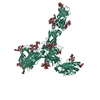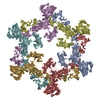[English] 日本語
 Yorodumi
Yorodumi- PDB-8qp0: A hexamer pore in the S-layer of Sulfolobus acidocaldarius formed... -
+ Open data
Open data
- Basic information
Basic information
| Entry | Database: PDB / ID: 8qp0 | ||||||
|---|---|---|---|---|---|---|---|
| Title | A hexamer pore in the S-layer of Sulfolobus acidocaldarius formed by SlaA protein | ||||||
 Components Components | S-layer protein A | ||||||
 Keywords Keywords | STRUCTURAL PROTEIN / S-layer / dimer / N-glycosylation / archea | ||||||
| Function / homology | : / S-layer / extracellular region / S-layer protein A Function and homology information Function and homology information | ||||||
| Biological species |   Sulfolobus acidocaldarius DSM 639 (acidophilic) Sulfolobus acidocaldarius DSM 639 (acidophilic) | ||||||
| Method | ELECTRON MICROSCOPY / subtomogram averaging / cryo EM / Resolution: 11.2 Å | ||||||
 Authors Authors | Gambelli, L. / McLaren, M. / Isupov, M. / Conners, R. / Daum, B. | ||||||
| Funding support | European Union, 1items
| ||||||
 Citation Citation |  Journal: Elife / Year: 2024 Journal: Elife / Year: 2024Title: Structure of the two-component S-layer of the archaeon . Authors: Lavinia Gambelli / Mathew McLaren / Rebecca Conners / Kelly Sanders / Matthew C Gaines / Lewis Clark / Vicki A M Gold / Daniel Kattnig / Mateusz Sikora / Cyril Hanus / Michail N Isupov / Bertram Daum /     Abstract: Surface layers (S-layers) are resilient two-dimensional protein lattices that encapsulate many bacteria and most archaea. In archaea, S-layers usually form the only structural component of the cell ...Surface layers (S-layers) are resilient two-dimensional protein lattices that encapsulate many bacteria and most archaea. In archaea, S-layers usually form the only structural component of the cell wall and thus act as the final frontier between the cell and its environment. Therefore, S-layers are crucial for supporting microbial life. Notwithstanding their importance, little is known about archaeal S-layers at the atomic level. Here, we combined single-particle cryo electron microscopy, cryo electron tomography, and Alphafold2 predictions to generate an atomic model of the two-component S-layer of . The outer component of this S-layer (SlaA) is a flexible, highly glycosylated, and stable protein. Together with the inner and membrane-bound component (SlaB), they assemble into a porous and interwoven lattice. We hypothesise that jackknife-like conformational changes in SlaA play important roles in S-layer assembly. | ||||||
| History |
|
- Structure visualization
Structure visualization
| Structure viewer | Molecule:  Molmil Molmil Jmol/JSmol Jmol/JSmol |
|---|
- Downloads & links
Downloads & links
- Download
Download
| PDBx/mmCIF format |  8qp0.cif.gz 8qp0.cif.gz | 1.3 MB | Display |  PDBx/mmCIF format PDBx/mmCIF format |
|---|---|---|---|---|
| PDB format |  pdb8qp0.ent.gz pdb8qp0.ent.gz | Display |  PDB format PDB format | |
| PDBx/mmJSON format |  8qp0.json.gz 8qp0.json.gz | Tree view |  PDBx/mmJSON format PDBx/mmJSON format | |
| Others |  Other downloads Other downloads |
-Validation report
| Summary document |  8qp0_validation.pdf.gz 8qp0_validation.pdf.gz | 1.3 MB | Display |  wwPDB validaton report wwPDB validaton report |
|---|---|---|---|---|
| Full document |  8qp0_full_validation.pdf.gz 8qp0_full_validation.pdf.gz | 1.4 MB | Display | |
| Data in XML |  8qp0_validation.xml.gz 8qp0_validation.xml.gz | 200.7 KB | Display | |
| Data in CIF |  8qp0_validation.cif.gz 8qp0_validation.cif.gz | 318.8 KB | Display | |
| Arichive directory |  https://data.pdbj.org/pub/pdb/validation_reports/qp/8qp0 https://data.pdbj.org/pub/pdb/validation_reports/qp/8qp0 ftp://data.pdbj.org/pub/pdb/validation_reports/qp/8qp0 ftp://data.pdbj.org/pub/pdb/validation_reports/qp/8qp0 | HTTPS FTP |
-Related structure data
| Related structure data |  18127MC  7zcxC  8an2C  8an3C  8qoxC C: citing same article ( M: map data used to model this data |
|---|---|
| Similar structure data | Similarity search - Function & homology  F&H Search F&H Search |
- Links
Links
- Assembly
Assembly
| Deposited unit | 
|
|---|---|
| 1 |
|
- Components
Components
| #1: Protein | Mass: 151078.406 Da / Num. of mol.: 6 / Source method: isolated from a natural source Source: (natural)   Sulfolobus acidocaldarius DSM 639 (acidophilic) Sulfolobus acidocaldarius DSM 639 (acidophilic)References: UniProt: Q4J6E5 Has protein modification | Y | |
|---|
-Experimental details
-Experiment
| Experiment | Method: ELECTRON MICROSCOPY |
|---|---|
| EM experiment | Aggregation state: 3D ARRAY / 3D reconstruction method: subtomogram averaging |
- Sample preparation
Sample preparation
| Component | Name: S-layer of Sulfolobus acidocaldarius / Type: ORGANELLE OR CELLULAR COMPONENT / Entity ID: all / Source: NATURAL |
|---|---|
| Source (natural) | Organism:   Sulfolobus acidocaldarius DSM 639 (acidophilic) Sulfolobus acidocaldarius DSM 639 (acidophilic) |
| Buffer solution | pH: 4 |
| Specimen | Embedding applied: NO / Shadowing applied: NO / Staining applied: NO / Vitrification applied: YES |
| Specimen support | Grid material: COPPER / Grid mesh size: 300 divisions/in. / Grid type: Quantifoil R2/2 |
| Vitrification | Cryogen name: ETHANE |
- Electron microscopy imaging
Electron microscopy imaging
| Experimental equipment |  Model: Titan Krios / Image courtesy: FEI Company | |||||||||||||||
|---|---|---|---|---|---|---|---|---|---|---|---|---|---|---|---|---|
| EM imaging | Cryogen: NITROGEN / Electron source:
| |||||||||||||||
| Image recording |
|
- Processing
Processing
| EM software |
| ||||||||||||||||||||||||||||||||||||||||||
|---|---|---|---|---|---|---|---|---|---|---|---|---|---|---|---|---|---|---|---|---|---|---|---|---|---|---|---|---|---|---|---|---|---|---|---|---|---|---|---|---|---|---|---|
| Image processing | Details: Datasets were combined after particle-extraction in Relion then refined in M. | ||||||||||||||||||||||||||||||||||||||||||
| CTF correction | Type: PHASE FLIPPING AND AMPLITUDE CORRECTION | ||||||||||||||||||||||||||||||||||||||||||
| Symmetry | Point symmetry: C3 (3 fold cyclic) | ||||||||||||||||||||||||||||||||||||||||||
| 3D reconstruction | Resolution: 11.2 Å / Resolution method: FSC 0.143 CUT-OFF / Num. of particles: 2271 / Symmetry type: POINT | ||||||||||||||||||||||||||||||||||||||||||
| EM volume selection | Num. of tomograms: 86 / Num. of volumes extracted: 22950 | ||||||||||||||||||||||||||||||||||||||||||
| Atomic model building | PDB-ID: 7ZCX Accession code: 7ZCX / Source name: PDB / Type: experimental model | ||||||||||||||||||||||||||||||||||||||||||
| Refine LS restraints |
|
 Movie
Movie Controller
Controller





 PDBj
PDBj FIELD EMISSION GUN
FIELD EMISSION GUN